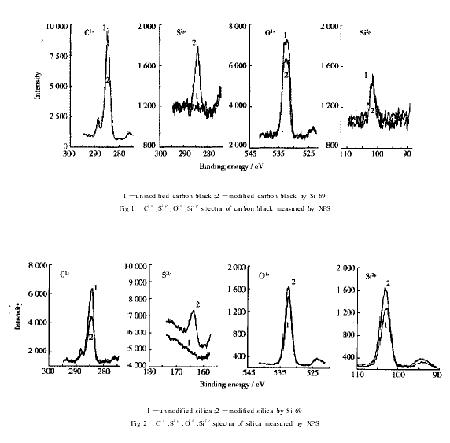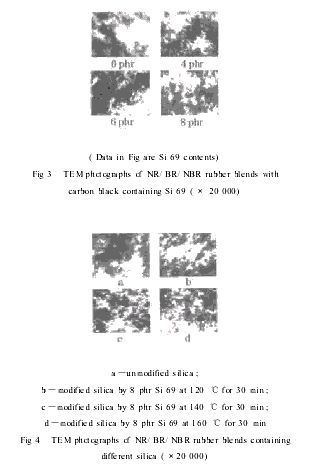Carbon black has been widely used as a stabilizer, antistatic agent, colorant, filler, and reinforcing agent in the rubber industry. Precipitation method white carbon black has reinforcing properties similar to carbon black [1]. The surface of carbon black contains some oxygen-containing groups such as phenolic, lactone, and carbonyl groups, while the surface of white carbon black has a uniform layer of silanol groups [2]. With the development of the tire industry and the demonstration of the advantages of white carbon black in reducing tire rolling resistance, the application of white carbon black in the rubber industry continues to expand. However, in applications, white carbon black must undergo surface modification to compensate for its performance shortcomings [3]. The commonly used surface modified silane coupling agent is bis - [3- (triethoxysilicon) propyl] tetrasulfide compound (hereinafter referred to as Si69). Currently, there are many literature reports on the application of Si69 in the rubber industry [4,5], but there are few reports on the interaction between carbon black and white carbon black and Si69. This work investigated the interaction between carbon black and silica with Si69 through extraction experiments, X-ray photoelectron spectroscopy (XPS), and transmission electron microscopy (TEM).
1 Experimental method
1.1 Raw material carbon black: High wear-resistant furnace black, grade N330, produced by Shanghai Tianma Carbon Black Factory; Precipitation method white carbon black: brand SR190, produced by the white carbon black plant of Taining Synthetic Ammonia Plant in Jiangsu Province; Si69: Produced by Guangzhou Nonferrous Metals Research Institute; All other additives are commonly used in the rubber industry.
1.2 Sample Preparation Modified Carbon Black (or White Carbon Black): Add carbon black (or white carbon black) to a three necked flask, stir while adding Si69 dropwise (with a mass ratio of 100/16), raise the temperature to 143 ℃, keep it warm, and continue stirring for 30 minutes. Cool down and discharge the material, seal it for use. Treat the carbon black (or white carbon black) without Si69 in the same way as above, then extract the sample with acetone under the same conditions for 24 hours, dry it in a 70 ℃ oven to a constant weight, weigh and calculate its loss rate Vulcanized rubber formula (mass fraction, same below): NR70, BR20, NBR10, 2.5 stearic acid, 4 zinc oxide, 4010NA2 anti-aging agent, DTDM0.5 accelerator, NOBS0.4 accelerator, carbon black (or white carbon black) 50, paraffin 1.2, aromatic oil 10, sulfur 1.5, Si69 (0,4,6,8). Place the mixed rubber overnight and prepare a vulcanized rubber sample at 143 ℃ x positive vulcanization time.
1.3 Performance testing XPS analysis: The sample was treated under high vacuum conditions for 4 hours and scanned and analyzed using the EscalabMK II XPS instrument from VG in the UK. The vacuum degree of the analysis room is 2.3 × 10-6Pa, and the energy flow is 20eV. C1s (284.6eV) is used for energy calibration, and the X-ray source is MgK α。 TEM analysis was performed using the LKB2088 ultra-thin slicer from LKB, Sweden. The samples were cut at low temperatures (-150~-130 ℃) and observed and photographed under the JEM-100C VII transmission electron microscope produced by Japanese electronics company.
2 Results and Discussion
2.1 Extraction analysis: Si69 with a mass fraction of 13.8% was added, and the weight gain of the reaction products between carbon black or white carbon black and Si69 was 4.3% and 5.3%, respectively. The results indicate that carbon black or white carbon black undergoes a chemical reaction with Si69. The oxygen-containing groups on the surface of carbon black form a certain chemical connection with Si69. At the same time, some Si69 may physically diffuse into the pore active points on the surface of carbon black, forming physical adsorption, which makes the modified carbon black more easily dispersed in rubber and improves the interfacial effect between rubber and carbon black. There are a large number of silanol groups on the surface of silica, which are prone to chemical reactions with Si69. After modification, covalent bonds are introduced between silica and polymers, which can improve the interaction between polymers and silica. The experiment also shows that the interaction between white carbon black and Si69 is stronger than that between carbon black and Si69.
2.2 XPS analysis XPS spectra can reflect the chemical state of elements. Any small change in chemical state, especially in the valence of elements, can cause the shift of characteristic peaks and changes in the shape of XPS spectra. As shown in Figure 1, the S2p characteristic peak is clearly observed in the modified carbon black, while the C1s, O1s, and Si2p characteristic peaks slightly weaken while the Si2p characteristic peaks strengthen, indicating that the surface chemical structure of the carbon black sample modified with Si69 has changed. The characteristic peaks of modified silica S2p and Si2p are significantly enhanced (see Figure 2), indicating the introduction of many Si and S elements on the surface of the modified sample; The characteristic peak intensities of the two increased by about 0.56 times and 0.25 times respectively compared to the unmodified one. The characteristic peak intensities of modified carbon black S2p and Si2p increased by about 0.50 times and 0.05 times respectively compared to unmodified ones (see Figure 1). The results indicate that the interaction between white carbon black and Si69 is higher than that between carbon black and Si69, which is consistent with the results of extraction weighing analysis.

2.3 TEM analysis shows that the dark part in Figure 3 is the carbon black phase. With the increase of Si69 dosage, the dispersion of carbon black tends to be uniform. When the amount of Si69 is 8 parts, the particle size of carbon black agglomerates is smaller, and the interface between the carbon black enrichment zone and the elastomer enrichment zone is more blurred. The carbon black phase forms a continuous network structure over a larger range, indicating that due to the coupling effect of Si69, the molecular chains of carbon black and elastomer can be better combined together. The dark part in Figure 4 is the phase of white carbon black. At 120 ℃, Si69 has limited improvement on the surface properties of white carbon black and cannot improve it well.

The fluidity of the sample results in insufficient dispersion; The dispersion of 140 ℃ modified white carbon black in vulcanized rubber tends to be more uniform, and the size of the dispersed phase is smaller; The dispersion effect of Si69 modified white carbon black in rubber is slightly worse at 160 ℃. The optimal temperature for modifying silica with Si69 is 140 ℃.
Conclusion a) Both carbon black and white carbon black can undergo chemical reactions with Si69, and Si69 has a stronger modification effect on white carbon black than on carbon black. The optimal temperature for Si69 modified white carbon black is 140 ℃. b) Si69 can effectively enhance the interaction between rubber and fillers, and improve the dispersion of carbon black and white carbon black in rubber.
 add wechat
add wechat

24 hours tle021-58997516

Mobi13321881626
Copyright © 2002-2022 ChiYe (shanghai) Co,ltd Address:Shanghai in China Case Number:沪ICP备14048717号-1 Siemap